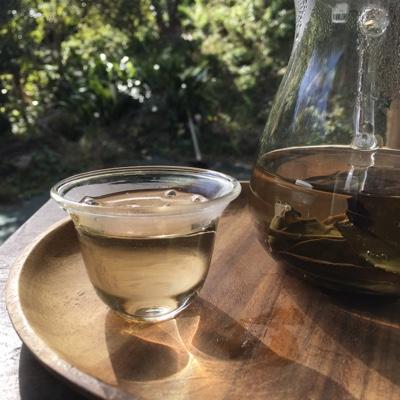こんにちは!今日は冬至を迎え、年末が近づいていますが、このブログ記事を読んでいただいている皆様が健康でいらっしゃることを願っております。
日本の典型的なお茶に詳しい方なら、4月末から5月初めがお茶の収穫の最盛期だと考えているかもしれません。夏の訪れと八十八夜のお茶摘みを歌った有名な日本の伝統的なお茶の歌があるからです。しかし、日本には「寒茶」と呼ばれる、一年で最も寒い時期に収穫される伝統的なお茶があります。「寒茶」は英語で文字通り「冷たいお茶」を意味します(つまり、「寒」は冷たい、「茶」はお茶を意味します)。これは、葉が冬に収穫されるためです。伝統的に、この時期は「立春」 (1月20日〜2月4日頃)または春の始まりの前の古い東アジアの暦で「大寒」(日本語:大寒;大きな寒さを意味する)に相当します。
現在、茶摘み時期は地域によって異なりますが、通常は1月から2月中旬にかけて行われます。つまり、寒茶は新年に最も早く収穫される茶葉と言えるでしょう。葉は冬の落ち葉のような外観で、幅広の番茶(粗い晩摘み茶)に分類されます。
 優しく甘い香りがする、厚くて幅広のカンチャの葉。写真はティーファーム水戸茶提供。
優しく甘い香りがする、厚くて幅広のカンチャの葉。写真はティーファーム水戸茶提供。
カンチャの作り方
寒茶用の茶樹と、現在一般的な日本茶(煎茶や玉露など)用の茶樹との大きな違いは、寒茶を作るために収穫される茶葉は、一般的に野生状態に放置された(つまり、人間の手入れや世話がほとんどない)茶樹から採取され、周囲の環境と共存している点です。そのため、寒茶の茶樹は、他の商業茶園のように手入れされることがなく、樹木に近い状態にあります。これは、茶樹を3年間育てて作られる三年番茶を思い起こさせるかもしれません。
寒茶のもう一つの特徴は、寒茶を作るための茶葉が手摘み、鋏、あるいは鎌(かま)で収穫されることです。葉は枝と共に収穫されます。収穫後、蒸し工程が続きます。他の日本の緑茶と比較すると、蒸し工程は30分から1時間とかなり長くかかります。蒸し後、葉と枝を分け、最後の工程として天日干し(てんびぼし)を行います。
寒茶の産地の一つである宍岱町では、収穫、蒸し、茶葉を一枚一枚手で揉み、混ぜ合わせ、再び手で揉むという工程を経て、さらに寒茶が作られます。こちらでは、寒茶作りの工程を写真でご覧いただけます(注:日本語の記事)。
 寒茶の蒸し工程。茶葉と茎は木樽で作られた蒸し器で蒸され、薪で沸かしたお湯から出る蒸気に乗せられます。写真は ティーファーム三戸茶提供。
寒茶の蒸し工程。茶葉と茎は木樽で作られた蒸し器で蒸され、薪で沸かしたお湯から出る蒸気に乗せられます。写真は ティーファーム三戸茶提供。
カンチャのバリエーション
カンチャは今ではかなり珍しいものですが、この民間茶には、起源となった地域に応じて主に 2 つの種類があります。
愛知県足助市
愛知県西尾市は上質な抹茶で有名ですが、足助(現在は豊田市に合併)という町も足助寒茶で有名です。 ティーファームみとちゃの若き茶農家、栢下悠樹さんは、日本の伝統的な民俗茶の保存に取り組んでおり、現在は足助村のスタイルで寒茶を作っています。彼の農園は奈良県にありますが、彼は足助村の農家から学びました。私は最近、彼の真備寒茶の薪冬緑茶を注文して試飲してみましたが、冬の茶葉がいっぱい入ったティーバッグを開けると、葉と太陽の心地よい甘い香りが漂ってきました!
 冬至に屋外でティーファームみとちゃの寒茶を楽しむ…そう、ティーカップにも長くてきれいな影ができるんです!
冬至に屋外でティーファームみとちゃの寒茶を楽しむ…そう、ティーカップにも長くてきれいな影ができるんです!
徳島県獅子久井市
甘茶の生産地であるもう一つの村は、徳島県の最南端に位置する宍喰町(ししくいちょう)です。ここは20軒ほどの農家が立ち並ぶ、山間の小さな集落です。この地域で甘茶を作っているおばあちゃんたちに聞いてみると、彼女たちはきっと自信を持って、様々な種類のお茶を飲んできたけれど、春の柔らかい新茶よりも冬に摘んだ粗い茶葉の方が栄養価が高く、甘みも一番強いと答えるでしょう。
実はこの村の人たちは、この茶畑を「野ネズミが作った茶畑」と呼んでいるんです。野ネズミが冬眠前にたくさん茶の実をついばんで食べるからなんです。カンチャの話を聞くまで、野生動物が栄養源として茶の実に興味を持っているなんて知りませんでした!野ネズミが茶の実を巣に運んだり、物置に隠したりする姿が可愛らしいですね。でも、彼らは器用ではなく忘れっぽいので、どこからともなく芽を出し、茶の木に育っていきます。野ネズミのおかげで茶畑は自然と広がり、茶農家の人たちが意識的に茶の実を植えることで、いいチームワークが生まれているんですね!
足助と宍喰では、寒茶の原料となる茶葉は、比較的野生に近い茶畑から収穫されています。そのため、農薬や化学肥料を使用する必要がありません。寒茶畑は、山間の傾斜地にあることが多いです。しかも、商業茶畑のように森林と隔離されているのではなく、茶樹と木々が共存しています。例えば、夏には落葉樹が自然の日陰を作り、茶樹が過度の日差しを浴びて苦味を増すのを防ぎます。秋には、クヌギなどの木々が葉を落とし、茶樹に自然の肥料を与えます。こうした自然環境は、野ネズミやイノシシといった野生の山岳動物との良好な共存関係を保っています。しかし、寒茶の残念な点は、生産量が少ないこと、そしてこのお茶を淹れる人が少数しかいないこと、そして淹れ方を知っている人の高齢化が進んでいることです。とはいえ、カンチャは市場ではあまり売られておらず、主に地元の人々のための飲み物です。そのため、カンチャは希少な民俗茶とされています。
さて、北半球で最も昼が短い日なので、このブログ記事は短くて軽い内容にまとめたいと思います。関連記事をもっと読みたい方は、ぜひ以下のリンクをご覧ください。どうぞお楽しみください!
さらに読む/関連記事
- 日本茶発見:三年番茶
- 日本の伝統的な民芸茶を守る「茶園みとちゃ」の茶農家、栢下悠樹さんへのインタビュー
- 地域限定の擬音語茶
- 玉露、かぶせ茶、煎茶、番茶の違い
注目の画像:茶園みとちゃの真備寒茶薪冬緑茶。


